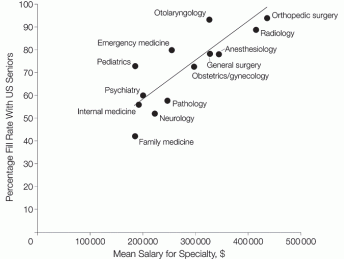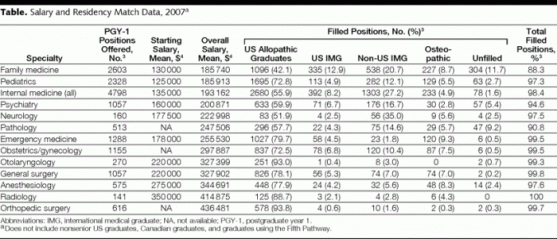Primary Care Medicine--Undervalued in America

Our nation's primary care physicians functions as the backbone of our health care system. Their importance to the health of our country cannot be overstated. Study after study have found that an increased number of pediatricians, family physicians, and general internists within a community leads to a measurable improvement in the health of that community. This effect can be seen at the state, county and city level. Unfortunately, several recent studies and surveys also portray these same crucial primary care physicians as a community under siege. One key reform to improve the vitality of our nation's primary care network would be the equalization of compensation between our primary care and specialty physicians.
According to a recent survey by the Physicians' Foundation, an overwhelming 78% of American physicians believe that there is a need for more primary care doctors in the United States today. This shortage is extremely detrimental to both the quality of our nation's health care, and it leads, paradoxically, to higher health care costs across the country. These findings have repeatedly been observed in several recent studies. For example, in 2007, researchers reporting in the International Journal of Health Services (see below for an important note on sources) found that an increased primary care physician supply in the United States is correlated with lower mortality from cancer, heart disease, and stroke; it also lessened the infant mortality rate, increased life expectancy and increased the self reported health of individuals. Limiting results to all-cause mortality, a common public health benchmark, these authors found that an increase of just 1 primary care physician per population of 10,000 people resulted in a 5.3% reduction in mortality for the year 2000 (the year under analysis). On a national level, this would translate into 127,000 deaths potentially averted in that year alone. The authors did not attempt to quantify improvements in quality of life brought by an increased supply of primary care doctors, but this is also likely very significant.
One reason for this improved health is improved primary prevention in communities well served by primary care doctors. Studies have shown an increase in diagnosis of early stage breast cancer and melanoma (rather than late stage), and a lower incidence of advanced stage cervical cancer in populations with a higher primary care physician supply. Most mammograms are ordered by primary care physicians, and people with an adequate primary care source are more likely to receive blood pressure screening and Pap smears. Unfortunately,none of these metrics are affected by the specialty physician supply; however, all of these improvements in quality and outcome are achieved while lowering costs. A recent analysis of state Medicare costs shows that increasing the number of general practitioners in a state by 1 in 10,000 population both increases the state's health care quality and reduces overall spending by $684 per beneficiary; therefore, increasing the number of primary care doctors would seem to be part of the magic elixir for lowering costs while raising quality of care that our country has been desperately searching for. Based upon all of the above data, one must agree that increasing our nation's supply of primary care physicians should be a top policy priority.
While many factors, unfortunately, likely limit the appeal of primary care to medical students and, thereby, deprive our country of an adequate number of primary care physicians, differences in compensation between primary care and specialty physicians have been documented to be a key deterrent to a career in primary care. According to a recent study in the New England Journal of Medicine, medical school graduates are now facing unprecedented levels of debt. Nearly one quarter of medical students graduate with educational debt of $200,000 or more. The median yearly cost in 2008-2009 of attending medical school is $44,390 at public schools and $62,243 at private schools. When this educational debt is added to the costs of starting a new life as a practicing physician and likely new parent with a house and all of the trappings of young adulthood, can we wonder that our newly minted residency trained physicians gravitate toward the more richly reimbursed careers in medicine? These careers are not in primary care. Please evaluate the chart above from a study published last September in the Journal of the American Medical Association. There is a nearly 100% correlation between residency fill rates with American medical school graduates and careers in medicine with the highest earnings. Now, please look at the chart below from the same article: (Click to see larger image)
This inequality of reimbursement arises from the fact that our American system pays much more for procedures than for the medical management of patients; therefore, specialists, like orthopedists or radiologists who do many procedures, are paid much better than physicians who work everyday treating their patients with medicine, lifestyle changes, and similar therapies. In my specialty of orthopedics, Medicare will approve a charge of approximately $60 for my most common office visit charges; Medicare will allow a charge of over $350 for a very common surgery, a carpal tunnel release, and over $1100 to fix a fractured hip. The carpal tunnel release takes me about as much time as a simple patient office visit and less time than a difficult office visit while the hip surgery will routinely take about as much time as 3 or 4 patient office visits. These variations in allowed charges result in the reimbursement inequalities plaguing the American medical system, and the great extent of these variations cannot be rationally justified.
(Click here for a 2010 survey of practice income which still sadly shows family practice trailing specialty medicine. Open PDF file on landing page.)
As our nation's leaders ponder and work toward significant reform of our health care system, we submit that addressing these inequalities in reimbursement must be a priority in any new system. Our country cannot tolerate a reduced supply of primary care physicians and the decreased health of our citizenry that this engenders. We specialty physicians should be quite proud of the enormous contributions that we make to the health of our patients, but we cannot claim that our therapies are more important than preventing a patient's stroke by managing his or her hypertension, or optimizing a patient's heart function to prevent his or her premature death. Specialists need to view reimbursement from the vantage point of our primary care colleagues; orthopedists and other specialty physicians have long and vigorously opposed Medicare's sustainable growth reimbursement cuts because, by and large, most of us feel that we cannot afford this reduction in our reimbursement. Imagine then the stress our system of reimbursement places on family doctors and other generalists whose compensation is well less than half of our own. Can we envision accepting a 60% reimbursement cut? We as a specialist community would never willingly tolerate this, but that level of compensation is the current average for family physicians in this country. In a recent large survey of primary care physicians, only 17% felt that their practices were "healthy and profitable". We, as specialty physicians, should support policies and reimbursement rates that close the reimbursement differences between physicians and, therefore, improve the viability of primary care medicine. While new policies may come with a cost to specialists, the benefit to our patients' collective health must be our primary concern.
Unfortunately, many references above are only available through the web to those with a paid subscription. Here those are below.
Baicker K, Chandra A. Medicare spending, the physician workforce, and beneficiaries' quality of care. Health Aff (Millwood)2004;W184-W197
Starfield B, Shi L, Grover A, Macinko J. The effects of specialist supply on populations' health: assessing the evidence. Health Aff (Millwood)2005;W5-97
Macinko S, Starfield B, Shi L. Quantifying the health benefits of primary care physician supply in the United States. Int J Health Serv 2007;37:111-126
Bodenheimer T, Grumbach K, Berenson RA. A lifeline for primary care. N Engl J Med 2009;360:2693-2696
